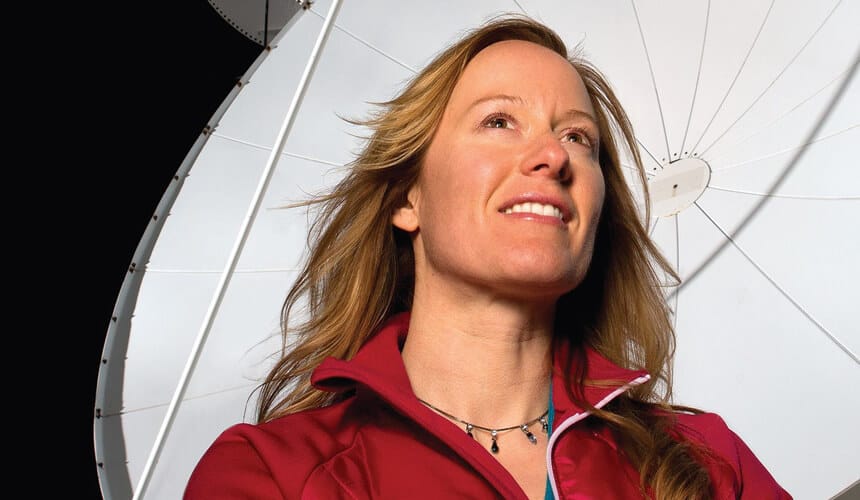Margaret Turnbull
The Planet Hunter
It’s not uncommon to see a lot of stars in the night sky over tiny Antigo, Wisconsin. But when Margaret Turnbull BS1998 looks up from her back porch, she sees something that most others don’t: possible new neighbors — and new homes for humans.
Turnbull was passionate about space from a young age, but she fretted over her career prospects as an astronomy major at UW–Madison. When the movie Contact was released the summer before she graduated, Turnbull’s doubts disappeared. “[By] the end, I was practically standing on my chair saying, ‘That is what I’m supposed to do with my life!’”
While pursuing her graduate studies at the University of Arizona, Turnbull approached astronomer Jill Tarter, then the director of the Center for SETI — the Search for Extraterrestrial Intelligence — about a research position. It was only after Turnbull relocated to work for the California-based lab that she realized Tarter was the scientist who had inspired Jodie Foster’s character in Contact.
“Maggie is a unique individual,” Tarter says of Turnbull. “She has a huge amount of energy, she’s pretty fearless, and she does things in her own way. When she was in graduate school in Arizona, there was no formal program in astrobiology, so she created her own graduate program.”
Under Tarter’s guidance, Turnbull developed the Catalog of Nearby Habitable Systems, or HabCat, to help scientists narrow down the list of almost 120,000 known stars to a much smaller list of 17,129 candidates for closer study. (Turnbull’s top 10 recommendations for stars that may be orbited by terrestrial planets are below.) HabCat remains a popular resource among astrobiologists.
From The Park
We’re not evolved to be pigeonholed.
Source: Used by permission of copyright holder.
Though HabCat, which became Turnbull’s PhD dissertation, made headlines worldwide, she struggled to find a place in traditional academia or scientific institutions. She ultimately decided to return to her native Wisconsin to pursue a more balanced life. Turnbull launched the non-profit Global Science Institute in Antigo and runs a variety of projects related to promoting science literacy across the state. She still collaborates regularly with astronomers at a variety of labs and consults for NASA.
Turnbull is still passionate about the search for life on other planets, though she encourages people to remember that life elsewhere may not look like life on Earth.
“It’s a very human tendency to want to put things in categories: this is alive and this other thing is not alive,” she says. “But those categories are artificial. The universe does not know anything about those categories. We want to be thinking in terms of a continuum. That continuum can be along whatever parameter — different behaviors, different relationships with other parts of the system. But defining life as a category — as something in a box and whatever is outside the box is non-life — will continue to produce exceptions.”
Turnbull’s Top 10
In 2006, Turnbull narrowed Habcat down to a handful of priority stars to explore for extraterrestrial intelligence (aliens!) and to consider as possible candidates for Earth-like planets.
These stars might be orbited by planets that could be home to other life forms:
- Beta Canum Venaticorum
Constellation: Canes Venatici/Hound Dogs
27 light-years away (one light-year is roughly 5.9 trillion miles)
Similar to our Sun in terms of mass and age. - HD 10307
Constellation: Andromeda
42 light-years away
Similar mass, temperature, and metal composition to our Sun. - HD 211415
Constellation: Grus/Crane
45 light-years away
Cooler than our Sun, with about half the metal content. - 18 Scorpii
Constellation: Scorpio
45.3 light-years away
Almost an identical twin to our Sun - 51 Pegasus (also known as Helvetios)
Contellation: Pegasus
50.9 light-years away
Orbited by a Jupiter-like planet. Named Dimidium, this is the first planet we discovered orbiting a Sun-like star.
These stars could be orbited by Earth-like planets that might be able to support humans:
- Epsilon Indi A
Constellation: Indus
11.8 light-years away
Only one-tenth as bright as our Sun. - Epsilon Eridani (also known as Ran)
Constellation: Eridanus/The River
10.5 light-years away
Somewhat smaller and cooler than the Sun. - Omicron2 Eridani (also known as 40 Eridani)
Constellation: Eridanus/The River
16 light-years away
Yellow-orange star roughly the same age as our Sun. - Alpha Centauri B
Constellation: Centaurus
4.35 light-years away, making it the closest star system to ours
One of two stars that together appear as the third-brightest star in the night sky. - Tau Ceti
Constellation: Cetus/Sea monster or whale
11.9 light-years away
The only star on the list as bright as our Sun
 85° F
85° F